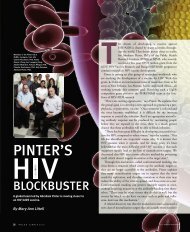changing the course of stroke - New Jersey Medical School ...
changing the course of stroke - New Jersey Medical School ...
changing the course of stroke - New Jersey Medical School ...
You also want an ePaper? Increase the reach of your titles
YUMPU automatically turns print PDFs into web optimized ePapers that Google loves.
IN RECOVERY<br />
“A<br />
s soon as <strong>the</strong> patient hits <strong>the</strong> ER, your critical care<br />
work has set in,” Yahia explains, emphasizing <strong>the</strong><br />
importance <strong>of</strong> a comprehensive neuro-intensive care unit (ICU)<br />
at all stages and especially in recovery. “You can have a wonderful<br />
intervention team quickly fix every blood vessel—intra-arterially,<br />
intravenously or mechanically—but that will account for<br />
only 30 percent <strong>of</strong> <strong>the</strong> patient’s chances for survival.” Outcome<br />
is still going to be determined by what happens afterward.<br />
Blood pressure, oxygen, infection control, body temperature,<br />
nutrition, and even management <strong>of</strong> fluids are critical.<br />
Meanwhile, protocols for care may differ from standard ICU<br />
strategies. “You need a neuro-intensivist in charge,” says Yahia,<br />
a trained neurologist who is also an endovascular care specialist.<br />
By becoming <strong>the</strong> patient’s advocate, a single neuro-intensivist<br />
can manage critically ill neurological patients better.<br />
In <strong>the</strong> case <strong>of</strong> a <strong>stroke</strong>, that calls for special knowledge. For<br />
example, <strong>stroke</strong> patients routinely suffer from cardiac suppression<br />
or dysfunction, and while <strong>the</strong>se heart problems may be<br />
transient, experience has shown that <strong>the</strong> need for oxygenation is<br />
greater than normal in such complex situations. In addition,<br />
“Someone with a <strong>stroke</strong> cannot communicate easily. Swallowing<br />
or breathing coordination can be difficult. Mental status is low.”<br />
A patient with a small hemorrhagic <strong>stroke</strong> and impaired swallowing<br />
can develop pneumonia, <strong>the</strong>n sepsis and end up in <strong>the</strong><br />
hospital for weeks.<br />
Swelling after a <strong>stroke</strong> is a common phenomenon and <strong>the</strong><br />
first 36 to 72 hours are critical. When <strong>the</strong> brain swells, it causes<br />
pressure on normal tissue and can lead to fur<strong>the</strong>r cell damage.<br />
The main goal for that initial period is to keep normal parts<br />
<strong>of</strong> <strong>the</strong> brain from being damaged, and to prevent <strong>the</strong> situation<br />
from becoming life-threatening. To get victims safely past <strong>the</strong><br />
swelling, medication can lower metabolism and oxygen requirement.<br />
Hypo<strong>the</strong>rmia, or reducing body temperature, also helps.<br />
Research on hibernating animals, who exist for months in states<br />
<strong>of</strong> hypo<strong>the</strong>rmia, show that slowing <strong>the</strong> metabolism <strong>of</strong> <strong>the</strong> brain<br />
and blood flow can give some injured tissue time to recover.<br />
However, don’t picture a body packed in ice. Yahia and Qureshi<br />
have used a ca<strong>the</strong>ter with cooling power in <strong>the</strong> large distal vein.<br />
Inserting this special ca<strong>the</strong>ter into one <strong>of</strong> <strong>the</strong> veins in <strong>the</strong> groin<br />
and sliding it up to <strong>the</strong> abdomen, <strong>the</strong>y have managed to lower<br />
internal temperature and maintain it that way for 24 to 48<br />
hours. Results are encouraging. In critical situations when medical<br />
management has been exhausted, temporarily removing<br />
part <strong>of</strong> <strong>the</strong> skull to allow tissue to protrude is a life-saving<br />
option.<br />
Abutaher M. Yahia, Brian Greenwald, and<br />
Patrick Pullicino (clockwise from top right)<br />
Part <strong>of</strong> every recovery plan must<br />
include a comprehensive <strong>stroke</strong><br />
evaluation workup. “Patients are<br />
going home only to return with ano<strong>the</strong>r <strong>stroke</strong>,” Yahia laments,<br />
explaining <strong>the</strong> high occurrence <strong>of</strong> recurrent attacks in <strong>the</strong> first<br />
weeks. Approximately 25 percent <strong>of</strong> people who have <strong>stroke</strong>s<br />
will have ano<strong>the</strong>r within five years, and that risk is greatest right<br />
after <strong>the</strong> first. Releasing a patient from <strong>the</strong> ICU, without first<br />
determining where <strong>the</strong> clot originated is an error made too<br />
<strong>of</strong>ten in hospitals not designed for comprehensive <strong>stroke</strong> management.<br />
“Of all <strong>stroke</strong>s, <strong>the</strong> carotid artery occlusive diseases<br />
contribute 10 percent and <strong>the</strong> intracranial occlusive diseases<br />
contribute ano<strong>the</strong>r 10 percent. But in <strong>the</strong> remaining 80 percent<br />
<strong>of</strong> acute ischemic <strong>stroke</strong>s, <strong>the</strong>re are cardiac sources <strong>of</strong><br />
embolism.” Relying only on a carotid Doppler and an MRI<br />
scan <strong>of</strong> <strong>the</strong> brain, and finding nothing, means “<strong>the</strong> investigation<br />
has not been thorough enough,” Yahia says.<br />
“Look at this,” he says. The image on his computer <strong>of</strong> <strong>the</strong><br />
beating heart <strong>of</strong> a patient who suffered a <strong>stroke</strong> earlier, clearly<br />
predicts danger. Anyone can see <strong>the</strong> waxy, gelatinous buildup <strong>of</strong><br />
plaque right <strong>the</strong>re on <strong>the</strong> screen. Like a swatch <strong>of</strong> fabric caught<br />
and waving in a stream <strong>of</strong> water, <strong>the</strong> fatty deposit actually flutters<br />
precariously with each beat <strong>of</strong> <strong>the</strong> man’s heart. “A piece<br />
probably broke <strong>of</strong>f to give him <strong>the</strong> <strong>stroke</strong>, but notice how much<br />
more is still <strong>the</strong>re on his aorta. Eighty percent <strong>of</strong> <strong>stroke</strong> patients<br />
have o<strong>the</strong>r sources <strong>of</strong> emboli, and <strong>the</strong> simplest diagnostic thing<br />
that I can do is probe and check.”<br />
Under conscious sedation and local anes<strong>the</strong>sia, using a transesophageal<br />
echocardiogram, cardiac sources <strong>of</strong> clots can be<br />
identified. Yahia takes only 10 to 15 minutes with a tool that<br />
has been on <strong>the</strong> market for 10 years. In a few hours, a plan to<br />
modify <strong>stroke</strong> risk factors (hypertension, heart disease, diabetes,<br />
blood cholesterol) as well as lifestyle indicators (smoking, alcohol<br />
consumption, exercise, diet) can be based on more than<br />
Continued on page 23<br />
N EW JERSEY MEDICAL SCHOOL<br />
17






